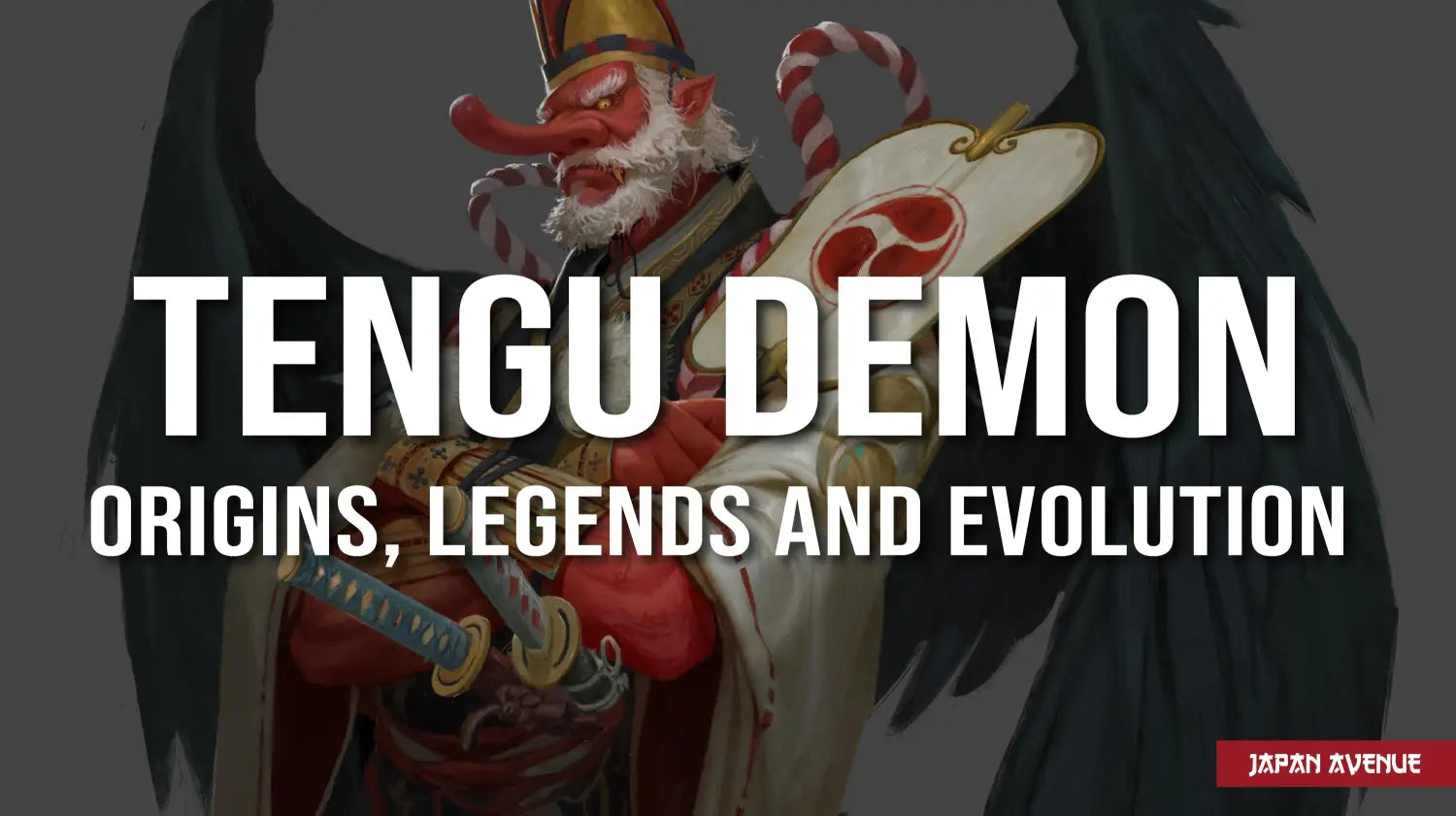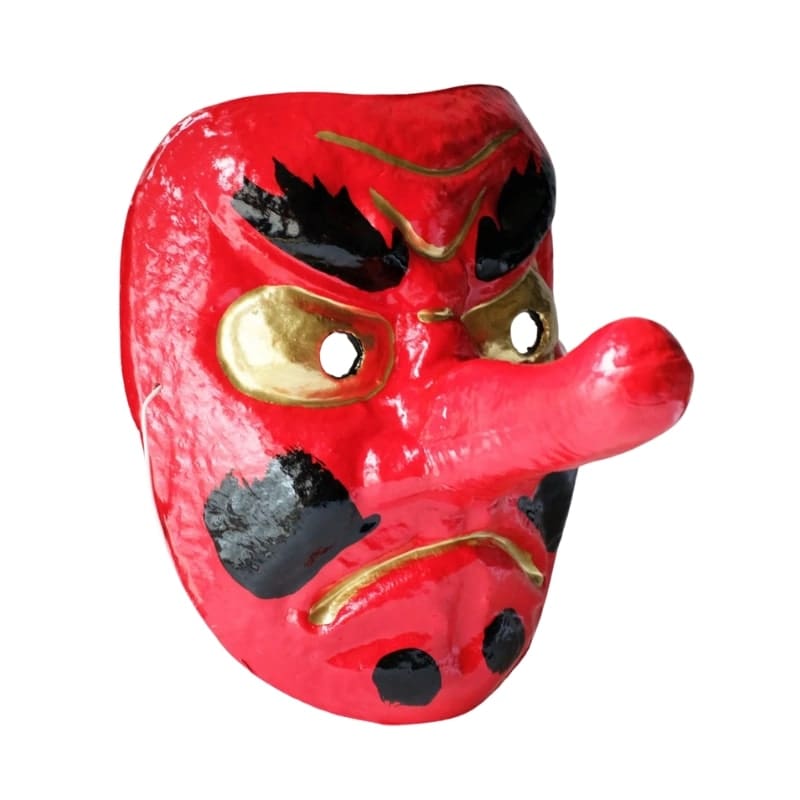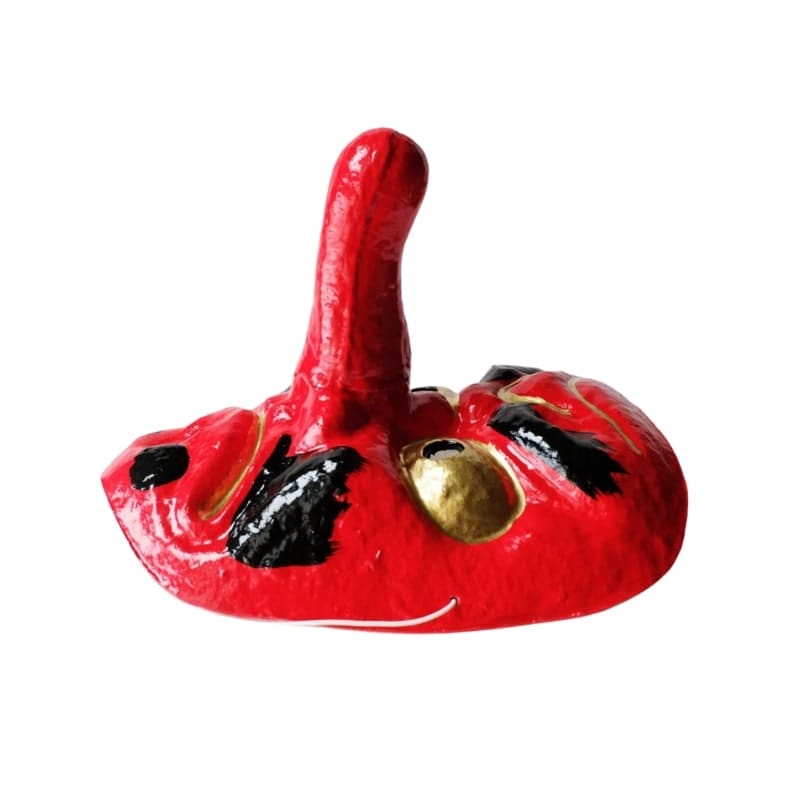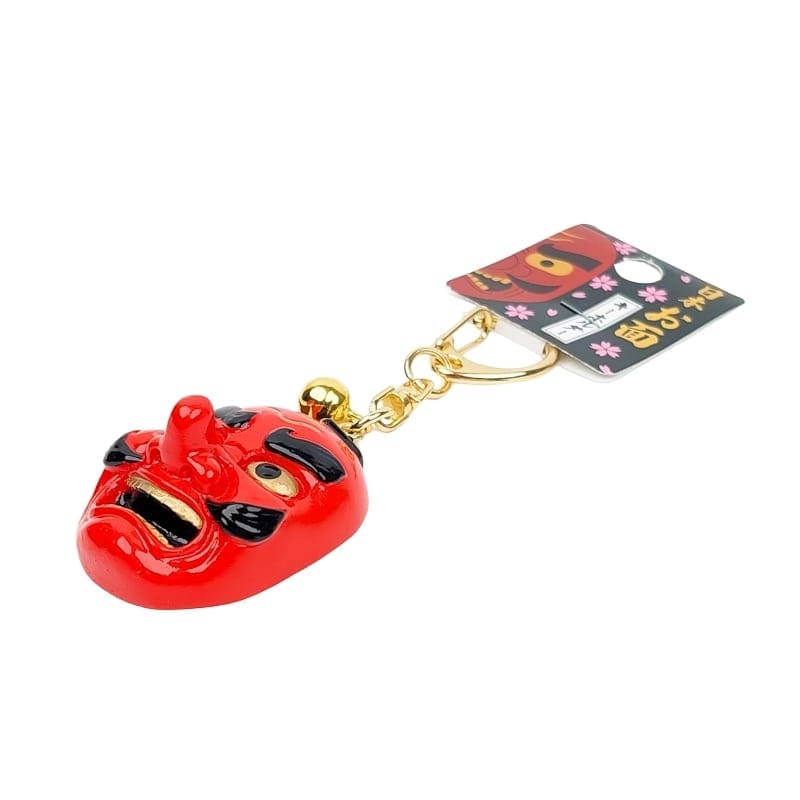Do you know about the Tengu? If you're a Japan addict, his face certainly isn't unfamiliar to you.
With his red face and long nose, the Tengu demon (天狗) is a very popular creature in Japan. Belonging to the yokai family, he is also considered to be a kami (or Shinto deity) ruling over the mountains and forest.
But what is hidden behind this emblematic figure of Japan? Who is this famous demon? Why is he so much revered?
Discover the portrait of the Tengu, its origins, and its place in traditional and modern Japanese culture.
Portrait of the Tengu : so, what does he look like?
This long nosed demon 👺 is part of the yokai - invisible creatures that rule the universe the Japanese love so much. They are ghosts, demons and other supernatural beings who, for the most part, possess magical powers. The Tengu is also considered a deity (or kami) in the Shinto religion, associated to the protection of the mountains and the forest.

Representation of the Tengu demon by Antonio J. Manzanedo (left) and Ai Tatebayashi (right)
With his angry look and crimson face, the Tengu is quite scary. His long nose resembles that of Saruta Hiko, another famous Shinto deity in Japan. He has some avian attributes such as wings that allow him to fly. Moreover, you will often see him dressed as a Yamabushi, the ascetic warriors living in the mountains of which the Tengu is said to be the sacred guardian.
In old depictions from Japanese illustrated scrolls (Tengu-sōshi), the Tengu is associated to proud Buddhist priests who turned into demons when they died. Later, it was also linked to the ascetic practices of the Yamabushi and the art of combat. ⚔
In traditional Japanese paintings and sculptures, the Tengu carries various accessories, such as the monk's staff, a feather fan allowing him to blow the wind or even warrior's weapons.
Moreover, his appearance changed a lot over time. Half-man, half-bird, throughout the years he looks more and more like a heretic Buddhist priest of whom he would be the reincarnation. His long nose would then be an ancient vestige of the beak he had in his old days. 🐦
Japanese Tengu mask and its meaning
The Tengu demon mask is a very common part of Japanese culture: in theaters, festivals, Shinto celebrations, manga and anime; it can be found everywhere. It must be said that his frightening face is perfect to mark people's mind. More than that, this mask is also used for scaring and keeping away the evil spirits.
Be careful not to confuse the Tengu with the famous Japanese demon Hannya. Both of them have a red face and a frightening facial expression. While the Tengu is differentiated by its long nose, Hannya's characteristics are horns and long sharp teeth.
Tengu' origins: where does he come from?

Amanozako representation (©NickTheBarbarian) / Garuda representation (©Kailash Raj)
The first stories about the Japanese Tengu came from the Nihon Shoki, a very old historical book dating back to the year 720. Later, Japanese art, fairy tales and urban legends also greatly contributed to the popularity of this demon. Numerous stories about Tengu have literally pushed the angry yokai into the Japanese folklore.
However, there are different opinions about its origin and, so far, there is no concrete evidence to validate the different theories. That's why we' re going to expose some of them in order to make an idea yourself:
Theory #1: The Chinese Tiāngou
The Japanese Tengu probably comes from the Chinese Tiāngou, a "canine-cosmic" monster that looks like a dog crossed with a comet (or a shooting star), and whose name means "Celestial Dog". Originally, its existence was used to provide explanations for eclipses, which were not understood at that time.
In China, the Tiāngou is a fearsome creature, fond of war and who eats men. Although the Japanese Tengu has adopted some of these characteristics, the physical resemblance is not very convincing. As a matter of fact, it's hard to find the dog aspect at first sight. 🐺
Theory #2: The Shinto deity Amanozako
According to the Kujiki, a book of reference on Japanese mythology, the Tengu is said to be descended from a Shinto deity named Amanozako, with whom he shares some similarities. Half woman, half bird, this monstrous and angry goddess also had a long nasal appendage.
Amanozako is said to be the result of the anger of Susanoo, god of the storm. This may explain why her Tengu descendant sometimes carries a fan.
Theory #3: The Hindu Goddess Garuda
Other historians believe that Tengu originated from an eagle-like Hindu deity 🦅. Like the Tengu, this mythical creature was feared by men of faith before becoming guardian of Buddhism.
The Japanese legends of Tengu
Whether seen in traditional festivals, literature, No theater or in the media, Tengu is very popular in Japanese folklore and contributes to the richness of its culture. As a result, legends around the Tengu yokai are not lacking.
Minamoto no Yoshitsune and King Sojobo
Adept of martial arts 🥋, the Tengu is known to perfectly handle weapons. The bow, the najinata and the sword hold no secrets for him.
Moreover, the well-known samurai Minamoto no Yoshitsune is said to have defeated the Taira clan thanks to the training he received from Sojobo, the extremely powerful Tengu king.
After his father was killed by the Taira, the young Minamoto no Yoshitsune was exiled to Mount Kurama. While crossing the valley, he met Tengu Sojobo who became his friend. Sojobo, a former Yamabushi, proposed to train him to fight in order to take his revenge on the Taira. This is how Minamoto no Yoshitsune was able to defeat his enemy.

Minamoto no Yoshitsune training with Tengu Sojobo.
The enemy of Buddhism
Did you know that, unlike many Yokai, the Tengu has another peculiarity besides its big nose? In fact, he hated Buddhism at one time. The Tengu was particularly hostile towards monks and temples because of its preoccupation with the Shinto religion.
In the legends of the Konjaku monogatari shū collection from the Heian era, he kidnaps and distracts priests from their faith as well as pious people.
As an enemy of Buddhism, he also attacked the imperial family. Thus, the emperor Sanjo is said to have been the victim of a Tengu, who would have turned him blind in order to take revenge on him.
In many stories, priests or pious people who are too vain to go to heaven, turned into Tengu more or less powerful according to their level of intellectual knowledge.
In Japan, the expression "Tengu ni natta" or "to become a Tengu" has its origin in these legends. It is a way to designate a particularly proud person.
The different types of Tengu
There exist various categories of Tengu deities in Japan. The more cultured and powerful ones are the Great Tengu, while the Small Tengu, are less evolved and more ignorant.🧐

Daitengu (©studiomuti) / Konoha Tengu (©svenstoffels) / Karasu Tengu (©Flying-Fox)
The Daitengu
These are the Great Tengu. They are wise and spiritual beings living on top of mountains. Rather benevolent, they remain particularly dangerous when they are angry.
These highly venerated deities have a humanoid appearance with a long nose and wings reminding us of their avian origins. The longer their nasal appendage, the more powerful they are.
Their main function is to rule the mountain. Thus, they are able to fly, make wind blow and generate natural disasters. As experts in the art of combat, they master the sword like no other.
Sometimes they kidnap men who venture in the forests as a punishment or to teach them magic. These powerful Tengu would also have the power to enlarge the nose of humans. Pinocchio 🤥 would thus have been victim of a bad spell from this demon?
The Karasu Tengu
The Raven Tengu have many physical attributes related to birds 🦅. They kept the old appearance with a beak. Also called Kotengu, they are the servants of the Great Tengu and can take possession of men or even metamorphose to play tricks on them. Less powerful than their leaders, they are easily fooled by humans and inspire some humoristic Japanese stories.
The Ona Tengu
They are former Buddhist nuns transformed into demons 👿 because of their overly conceited nature. They are part of the Raven Tengu and seduce men before revealing their true nature.
The Koh Noha Tengu
These are more like wolves 🐺 and their role is to bring food to the Big Tengu, in exchange for doing favors for the humans. Unlike the Small Tengu, they do not know how to fight.
The Guhin
The last members of the hierarchy, they are rather benevolent with the humans of which they are the mediators with nature 🌿. But be careful, they can still cause storms when they are upset.
Significance of the Tengu over the years

Representation of Tengu by Cristian AC
The image of Tengu has evolved a lot throughout the history of Japan. Originally, he was considered as an evil and aggressive demon, fond of fighting and kidnapping monks and children or possessing women.
Then, little by little, his image was softened. The Tengu lost his hostility towards Buddhism and became the protector of the mountains and forests.
Over the centuries, the Tengu became a benevolent guardian of sacred Buddhist texts and places. Likewise, the Tengu would play evil tricks on arrogant or lawless people.
Nowadays, the Tengu is not to be feared anymore. Instead, some people tend to make fun of him. If he brings good luck and protects families by warding off evil spirits, he still remains unpredictable, as does the nature he protects.
Tengu's place in Japanese culture
Tengu has an important place in Japanese traditions through religions, literature and arts. Still today, many events are dedicated to him. We can mention the Tengu Saburo cults at Mount Izuna, Sojobo at Mount Kurama or the Saruta Hiko cult in Susuka city.

Parade during the Numata festival in honor of Tengu.
If you happen to be visiting Japan, here are also some festivals not to be missed to see these famous demons:
In August, don't miss the Tengu masks at the traditional Bon festival, a ritual in honor of the ancestors. Also, during the very popular Numata festival which celebrates the Tengu of Kashouan mountain, you will find two gigantic masks being paraded.
In February, experience a parade of floats in honor of this legendary creature at the Tenkaichi Tengu parade in Tokyo.
You can also meet these demons at the Osaka festival, Furubira festival in Hokkaido or in the streets of the Shimokitazawa district in Tokyo.

Tengu festival in Shimokitazawa district, Tokyo. (©balbo42)
Still today, in arts as well as in Japanese literature, the Tengu is a true source of inspiration. Whether in paintings, Noh theater plays where we can find its characteristic mask or in manga and video games: this demon is not about to be forgotten.
Now that you know everything about this mythical creature, be careful not to take the big head if you don't want to be told "Tengu ni natta".







